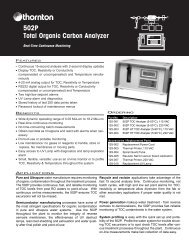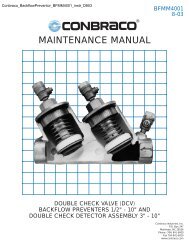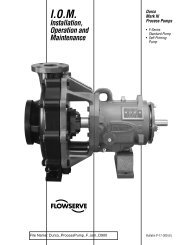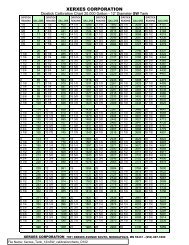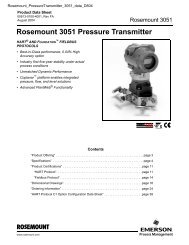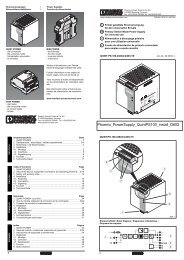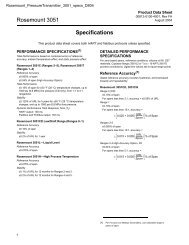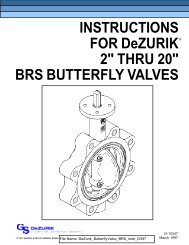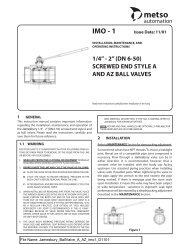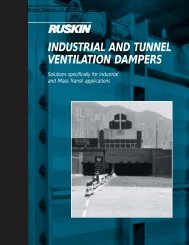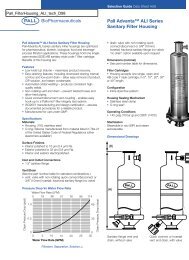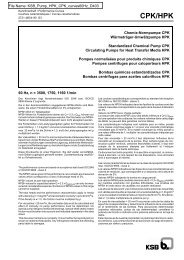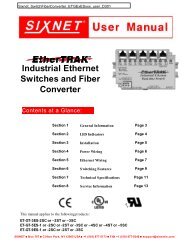Operation and Maintenance Manual for
Operation and Maintenance Manual for
Operation and Maintenance Manual for
You also want an ePaper? Increase the reach of your titles
YUMPU automatically turns print PDFs into web optimized ePapers that Google loves.
USFilter<br />
10 Technology Drive<br />
Lowell, Massachusetts 01851<br />
Tel: (800) 875-7873 • Fax: (978) 441-6025<br />
Email:<br />
Lowell_TechSupport@USFilter.com<br />
<strong>Operation</strong> <strong>and</strong><br />
<strong>Maintenance</strong><br />
<strong>Manual</strong><br />
<strong>for</strong><br />
KFZSD<br />
KF Series<br />
Duplex Alternating<br />
Softener Systems<br />
With 1” <strong>and</strong> 1.5” Valves<br />
Catalog # _______________________<br />
Serial # ________________________<br />
68/KFZSD-030 – 01/04 Rev. 1
CAUTIONS AND WARNINGS<br />
Prior to operating or servicing this device, this manual must be read <strong>and</strong> understood. If something<br />
is not clear, call <strong>for</strong> assistance be<strong>for</strong>e proceeding. Keep this <strong>and</strong> other associated manuals <strong>for</strong><br />
future reference <strong>and</strong> <strong>for</strong> new operators or qualified service personnel.<br />
All electrical work should be per<strong>for</strong>med by a qualified electrician in accordance with the latest<br />
edition of the National Electrical Code, as well as local codes <strong>and</strong> regulations.<br />
To avoid electrical shock hazard, do not remove covers or panels when power is supplied to the<br />
device. Do not operate the device when covers or panels are removed.<br />
WARNING<br />
A faulty pump motor or wiring can be a serious shock hazard if it or<br />
surrounding water is accessible to human contact. To avoid this danger,<br />
DO NOT remove any grounding wire from the system.<br />
DISCLAIMER STATEMENT<br />
This operation <strong>and</strong> maintenance manual is intended to be used with the component manufacturer<br />
literature provided in the Appendix. These manuals should provide complete <strong>and</strong> accurate<br />
in<strong>for</strong>mation to meet your operating <strong>and</strong>/or service requirements based on the in<strong>for</strong>mation available<br />
at the time of publication. However, USFilter assumes no responsibility <strong>for</strong> the technical content of<br />
the manufacturer literature.<br />
This manual should be read fully <strong>and</strong> understood be<strong>for</strong>e installation, operation or maintenance of<br />
the system is attempted. The in<strong>for</strong>mation in this manual may not cover all operating details or<br />
variations or provide <strong>for</strong> all conditions in connection with installation, operation <strong>and</strong> maintenance.<br />
Should questions arise which are not answered specifically in this manual, contact the USFilter<br />
Technical Support Department at the phone number provided on the cover of this manual.<br />
USFilter reserves the right to make engineering refinements that may not be reflected in these<br />
manuals. The material in these manuals is <strong>for</strong> in<strong>for</strong>mational purposes <strong>and</strong> is subject to change<br />
without notice <strong>and</strong> should not be construed as a commitment by USFilter. USFilter assumes no<br />
responsibility <strong>for</strong> any errors that may appear in this document. This manual is believed to be<br />
complete <strong>and</strong> accurate at the time of publication. In no event shall USFilter be liable <strong>for</strong> incidental<br />
or consequential damages in connection with or arising from the use of this manual.<br />
©Copyright 2004 USFilter<br />
Printed in the United States of America. All rights reserved.<br />
THIS BOOK OR PARTS THEREOF MAY NOT BE REPRODUCED IN ANY FORM<br />
WITHOUT THE WRITTEN PERMISSION OF THE PUBLISHERS.
PROPRIETARY RIGHTS STATEMENT<br />
This manual discloses in<strong>for</strong>mation in which USFilter has proprietary rights. Neither receipt nor<br />
possession of this manual confers or transfers any right to the client, <strong>and</strong> by its retention hereof,<br />
the client acknowledges that it will not reproduce or cause to be reproduced, in whole or in part, any<br />
such in<strong>for</strong>mation except by written permission from USFilter. The client shall have the right to use<br />
<strong>and</strong> disclose to its employees the in<strong>for</strong>mation contained herein <strong>for</strong> the purpose of operating <strong>and</strong><br />
maintaining the USFilter equipment, <strong>and</strong> <strong>for</strong> no other purpose.<br />
In the event the content of this manual is altered or section/items are omitted during a reproduction,<br />
in whole or in part, <strong>and</strong> instructions or definitions within the reproduction result in personal injury to<br />
those who follow the altered instructions, the burden of responsibility <strong>for</strong> personal injury falls solely<br />
on the party who affects the reproduction.<br />
MANUAL USER’S GUIDE<br />
This manual describes the procedures necessary to install, operate, <strong>and</strong> maintain your USFilter<br />
Duplex Softener system. Please read this manual carefully be<strong>for</strong>e installing <strong>and</strong> operating your<br />
equipment. The equipment warranty may be voided if installation or operation instructions are not<br />
followed correctly.<br />
Warnings, Cautions, <strong>and</strong> Notes are used to attract attention to essential or critical in<strong>for</strong>mation.<br />
Warnings <strong>and</strong> Cautions will appear be<strong>for</strong>e the text associated with them, <strong>and</strong> notes can appear<br />
either be<strong>for</strong>e or after associated text.<br />
WARNING<br />
CAUTION<br />
Warnings indicate condition, practices, or procedures which must be<br />
observed to avoid personal injury or fatalities.<br />
Cautions indicate a situation that may cause damage or destruction of<br />
equipment or may pose a long term health hazard.<br />
NOTE: Notes are used to add in<strong>for</strong>mation, state exceptions, <strong>and</strong> point out areas that<br />
may be of greater interest or importance.<br />
EQUIPMENT SUPPORT<br />
USFilter continually strives to provide safe, efficient, trouble-free equipment using the optimum<br />
technology <strong>for</strong> your application. If problems should develop, USFilter’s worldwide network of<br />
technical support will be available to provide assistance. For service, sales, parts, or additional<br />
manual copies call your area representative or USFilter, Technical Support Department at the<br />
number provided on the cover of this manual.
TABLE OF CONTENTS<br />
SECTION DESCRIPTION PAGE<br />
1.0 INTRODUCTION<br />
1.1 System Function...................................................................................1-1<br />
1.2 Quality Assurance/Quality Control........................................................1-1<br />
1.3 System Part Numbers ..........................................................................1-2<br />
1.4 System Specifications ..........................................................................1-3<br />
2.0 SYSTEM INSTALLATION<br />
2.1 Equipment Included..............................................................................2-1<br />
2.2 Precautions Be<strong>for</strong>e Installation.............................................................2-4<br />
2.3 Installation of Media .............................................................................2-4<br />
2.4 Valve <strong>and</strong> Piping Installation ................................................................2-6<br />
2.5 3200NT Controller Wiring.....................................................................2-9<br />
3.0 OPERATING INSTRUCTIONS<br />
3.1 Regeneration Setup .............................................................................3-1<br />
3.2 System <strong>Operation</strong>s...............................................................................3-1<br />
3.3 Troubleshooting ...................................................................................3-1<br />
4.0 SHUTDOWN AND STORAGE<br />
4.1 Shutdown <strong>and</strong> Storage Procedure........................................................4-1<br />
5.0 SAMPLING AND TESTING<br />
5.1 General Sampling <strong>and</strong> Testing Guidelines ...........................................5-1<br />
5.2 Sampling <strong>and</strong> Testing...........................................................................5-1<br />
5.3 Resin Sampling Procedure...................................................................5-2
TABLE OF CONTENTS<br />
SECTION DESCRIPTION PAGE<br />
6.0 MAINTENANCE<br />
6.1 General <strong>Maintenance</strong> Guidelines .........................................................6-1<br />
7.0 APPENDIX<br />
7.1 Glossary of Terms................................................................................7-1<br />
7.2 Replacement / Spare Parts List............................................................7-3<br />
7.3 QA Inspection Report ...........................................................................7-3<br />
7.4 Component Manufacturer Literature.....................................................7-3
KFZSD 1”/1.5” <strong>Manual</strong> 01/04 Rev. 1 INTRODUCTION<br />
1.0 INTRODUCTION<br />
Congratulations on your selection of this water purification system. This system is designed<br />
<strong>and</strong> manufactured to the highest st<strong>and</strong>ard of quality <strong>and</strong> fully inspected prior to shipment. In<br />
order to get maximum per<strong>for</strong>mance, we ask you to read all of the following instructions be<strong>for</strong>e<br />
installing <strong>and</strong> operating this system. Any warranty offered will be void unless directions are<br />
followed exactly.<br />
This manual is divided into sections <strong>for</strong> easy reference. Review this manual thoroughly <strong>and</strong><br />
then return to section 2.0 System Installation <strong>for</strong> step-by-step installation instructions.<br />
If you need technical assistance in operating or maintaining your unit, call your local<br />
representative. If you require further assistance call the Technical Support Department at the<br />
phone number provided on the cover of this manual.<br />
1.1 SYSTEM FUNCTION<br />
The function of your water softener is to reduce the hardness in feedwater using ion<br />
exchange resin. The water softener vessel contains high quality cation resin in the<br />
sodium <strong>for</strong>m that removes hardness. Hardness will create scale on reverse osmosis<br />
membranes, water heaters, boilers, <strong>and</strong> other equipment if not removed. Calcium,<br />
magnesium, <strong>and</strong> other cations removed by the resin are replaced with sodium ions. The<br />
resin has a fixed capacity based on the pounds of salt used per cubic foot of resin<br />
during regeneration. Flow rate, TDS, <strong>and</strong> other factors will dictate the actual capacity of<br />
the resin. When the capacity is exceeded, the resin will allow the hardness ions to pass<br />
through the unit. Be<strong>for</strong>e the capacity is exceeded, the unit is removed from service <strong>and</strong><br />
regenerated with a solution of sodium chloride (brine). Completion of the regeneration<br />
steps allows the water softener to be returned to the service mode.<br />
1.2 QUALITY ASSURANCE/QUALITY CONTROL<br />
We have defined Quality Assurance <strong>and</strong> Quality Control into a series of engineering <strong>and</strong><br />
manufacturing practices <strong>and</strong> control procedures to insure that you receive the finest<br />
product available in the world. We will continue to update these practices <strong>and</strong><br />
procedures on an ongoing basis in an ef<strong>for</strong>t to improve our systems <strong>and</strong> to insure that<br />
they continue to reflect state-of-the-art technology <strong>and</strong> reliability.<br />
Quality assurance is the cornerstone of our quality program. It begins with the selection<br />
<strong>and</strong> qualification of components <strong>and</strong> materials. Be<strong>for</strong>e suppliers are selected, their<br />
products must meet or exceed rigid st<strong>and</strong>ards set by our Quality Assurance<br />
Department. From that point, our incoming material inspection insures only reliable<br />
components will be used to manufacture systems. Numerous checks are per<strong>for</strong>med as<br />
the system passes through the manufacturing process. Included with the system is a<br />
copy of the QA Data Report that includes the check that all components are included.<br />
1-1
KFZSD 1”/1.5” <strong>Manual</strong> 01/04 Rev. 1 INTRODUCTION<br />
1.3 SYSTEM PART NUMBERS<br />
Sample Part Number KFZSD 009 F P Z V A X<br />
KFZSD KF Series Duplex Softener<br />
Softener Tank<br />
Size<br />
009 9” x 40”<br />
012 12” x 52”<br />
014 14” x 65”<br />
016 16” x 65”<br />
018 18” x 65”<br />
021 21” x 62”<br />
024 24” x 72”<br />
Vessel Material<br />
F St<strong>and</strong>ard Non-Code Fiberglass<br />
Control Rating<br />
P NEMA 3R<br />
Skid<br />
Z St<strong>and</strong>-alone unit, non-skid<br />
Control Type<br />
V 3200NT w/ Volume Initiation<br />
Pipe Size<br />
A 1”<br />
B 1.5”<br />
Resin Options<br />
X St<strong>and</strong>ard Volume<br />
Note: Not all model number combinations are available.<br />
1-2
Tank<br />
Size<br />
D x H<br />
(in)<br />
KFZSD 1”/1.5” <strong>Manual</strong> 01/04 Rev. 1 INTRODUCTION<br />
1.4 SYSTEM SPECIFICATIONS<br />
Table 1-1: Duplex Softener System Specifications<br />
Pipe<br />
Size<br />
(in)<br />
6 Resin<br />
Vol.<br />
(ft 3 )<br />
Gravel<br />
Wght<br />
(lbs 1 /8”<br />
x 1 /16”)<br />
2 Capacity<br />
@ 15#/ft 3<br />
dosage<br />
(Kgr)<br />
Max. Service<br />
Flow<br />
(gpm)<br />
Backwash/<br />
Rapid<br />
Rinse<br />
Flow DLFC<br />
(gpm)<br />
Inj.<br />
Size/<br />
Color<br />
Fill<br />
Flow<br />
BLFC<br />
(gpm)<br />
3 3<br />
Cycle Times @ 15#/ft<br />
dosage<br />
(minutes)<br />
RO<br />
Pretreat<br />
St<strong>and</strong><br />
Alone<br />
BW Brine<br />
In 4,5<br />
Slow<br />
5<br />
Rinse<br />
Fast<br />
Rinse<br />
Brine<br />
Fill 4<br />
9 x 40 1.0 1.0 none 30 3 19 2.0 1/W 0.5 10 22 30 10 12 18 x 40 350<br />
12 x 52 1.0 2.0 none 60 6 21 3.5 2/B 0.5 10 32 32 10 24 18 x 40 350<br />
12 x 52 1.5 2.0 none 60 6 39 3.5 2/B 0.5 10 32 32 10 24 18 x 40 350<br />
14 x 65 1.0 3.0 40 90 9 22 5.0 3/Y 0.5 10 26 46 10 32 24 x 50 700<br />
14 x 65 1.5 3.0 40 90 9 42 5.0 3/Y 0.5 10 26 46 10 32 24 x 50 700<br />
16 x 65 1.0 4.0 55 120 12 23 7.0 3/Y 0.5 10 34 58 10 44 24 x 50 700<br />
16 x 65 1.5 4.0 55 120 12 46 7.0 3/Y 0.5 10 34 58 10 44 24 x 50 700<br />
18 x 65 1.5 5.0 75 150 15 54 9.0 3C/Y 2.0 10 26 64 10 16 24 x 50 700<br />
21 x 62 1.5 7.0 100 210 21 52 12.0 4C/G 2.0 10 16 48 10 18 24 x 50 700<br />
24 x 72 1.5 10.0 175 300 30 68 15.0 5C/W 2.0 10 26 54 10 26 24 x 50 1,000<br />
Brine<br />
Tank<br />
D x H<br />
(in)<br />
1<br />
At higher salt dosages, the softener will treat more water between regenerations, create less overall waste, <strong>and</strong><br />
produce lower-hardness effluent. At lower salt dosages, the softener will use less overall salt. For dosages<br />
below 9 #/ft 3 , consult Technical Support at the number on this manual’s front cover.<br />
2 3<br />
For other salt dosages, use the <strong>for</strong>mula: Kgr capacity = (#(30 - #) + 16) / 8 x ft resin, where # = salt dosage in<br />
lbs/ft 3<br />
3<br />
The Brine In <strong>and</strong> Slow Rinse times are set on each valve timer as a single cycle time, which is the two cycle times<br />
added together.<br />
4<br />
For other salt dosages, adjust the Brine In <strong>and</strong> Brine Tank Fill times using this <strong>for</strong>mula: Cycle time = Time shown x<br />
Salt Dosage ÷ 15.<br />
5<br />
For an inlet pressure other than 35 psig, adjust the Brine In <strong>and</strong> Slow Rinse times using the graphs in Section 8.4<br />
<strong>and</strong> this <strong>for</strong>mula: Cycle time = Time shown x Flow at 35 psig ÷ Flow at actual psig.<br />
6<br />
For tank sizes that are listed with more than one possible resin amount, refer to the last letter of the model # (see<br />
above) to determine whether to use the minimum (Y), median (X), or maximum (Z) resin volume.<br />
7<br />
At higher salt dosages, use 70% of salt instead; if more salt is loaded, the tank may overflow during the Brine Refill<br />
step.<br />
1-3<br />
Max.<br />
Salt<br />
in Tk<br />
(lbs)
KFZSD 1”/1.5” <strong>Manual</strong> 01/04 Rev. 1 SYSTEM INSTALLATION<br />
2.1 EQUIPMENT INCLUDED<br />
2.0 SYSTEM INSTALLATION<br />
Your system has been shipped to you in the following assemblies. Check to make sure<br />
that none of these appear damaged or missing.<br />
Each softener assembly consists of the following components common to all softeners<br />
(see Figure 2-1):<br />
1. (1) Fiberglass vessel with PVC riser tube distributor assembly*<br />
2. (1) Control Valve with cover*<br />
3. (1) Tank-Valve bushing (<strong>for</strong> 16” tanks with 1” valves)*<br />
4. (1) Drain line flow control (DLFC) housing<br />
5. (1) Tube fitting <strong>for</strong> brine inlet line<br />
6. (1) Kit with assorted DLFC/injector parts<br />
7. (1) Upper Disperser (1.5” valves only)<br />
8. (1) Lot Cation Resin <strong>and</strong> gravel if necessary*<br />
9. (2) Operating <strong>Manual</strong>s*<br />
10. (1) Hardness test kit<br />
5<br />
7<br />
DLFC Washers<br />
6<br />
Injector Nozzles<br />
Injector Throats<br />
Figure 2-1 Components common to all softeners<br />
* = items not shown in photos<br />
4<br />
10<br />
2-1
KFZSD 1”/1.5” <strong>Manual</strong> 01/04 Rev. 1 SYSTEM INSTALLATION<br />
The brine tank assembly included with all softeners consists of (see Figure 2-2):<br />
11. (1) Brine tank with cover<br />
12. (1) Well with cap<br />
13. (1) Salt Grid<br />
14. (1) Overflow fitting<br />
15. (1) Air check/safety valve (<strong>for</strong> 18” brine tanks)*<br />
16. (1) Air check assembly (<strong>for</strong> 24” brine tanks)<br />
17. (1) 3/8” tube elbow, fittings (<strong>for</strong> 9” – 16” systems)*<br />
18. (1) 0.5” bushing, elbow, fittings (<strong>for</strong> 18” – 24” systems)<br />
19. (2) lengths tubing with tee (<strong>for</strong> duplex 9” – 12” systems)*<br />
20. (1) length 18’ tubing with tee (<strong>for</strong> 14” – 24” systems)*<br />
21. (1) Grommet <strong>for</strong> brine line hole in tank*<br />
14<br />
18<br />
13<br />
16<br />
12<br />
11<br />
Figure 2-2: Brine Tank Components<br />
* = items not shown in photos<br />
2-2
KFZSD 1”/1.5” <strong>Manual</strong> 01/04 Rev. 1 SYSTEM INSTALLATION<br />
The following alternating kit components are also included <strong>for</strong> the duplex system:<br />
22. (1) 25’ RJ45 phone cable*<br />
23. (1) 25’ 3-wire meter cable*<br />
24. (1) cable fitting with lock nut<br />
25. (1) remote meter with bracket <strong>and</strong> tester*<br />
24<br />
Figure 2-3: Alternating Kit Components<br />
The following valve <strong>and</strong> solenoid kit components are included with the duplex system.<br />
26. (4) end connectors <strong>for</strong> actuated valves*<br />
27. (2) normally-open (NO) valves w/ mounted <strong>and</strong> tubed 24VAC solenoid valve<br />
28. (1) ¼” Union Tee*<br />
29. (1) 20’ ¼” tubing*<br />
Figure 2-4: Normally Open Diaphragm Valve w/ mounted 24VAC Solenoid (1 shown of 2)<br />
* = items not shown in photos<br />
2-3
KFZSD 1”/1.5” <strong>Manual</strong> 01/04 Rev. 1 SYSTEM INSTALLATION<br />
2.2 PRECAUTIONS BEFORE INSTALLATION<br />
NOTE: Be sure to comply with all local, state, <strong>and</strong> federal codes.<br />
A. WATER PRESSURE: The regeneration valve needs 30 psi minimum pressure to<br />
operate effectively. Softeners with 16” x 65” vessels require a minimum of 40 psi.<br />
B. WATER TEMPERATURE: Feed temperature should be 45 – 100 °F.<br />
C. INLET TURBIDITY: Maximum inlet turbidity is 5 NTU.<br />
CAUTION<br />
Water pressure is not to exceed 110 PSI, water temperature is not to<br />
exceed 100 °F, <strong>and</strong> the unit cannot be subjected to freezing<br />
temperatures.<br />
D. ELECTRICAL FACILITIES: An uninterrupted 110V alternating current (AC)<br />
electrical supply is required. Make sure the supply is always on, <strong>and</strong> cannot be<br />
turned off with another switch.<br />
E. EXISTING PLUMBING: Existing plumbing should be free from lime <strong>and</strong> iron<br />
buildup. If piping is clogged with iron, a separate iron filter unit should be installed<br />
ahead of the water softener.<br />
F. LOCATION: The softener should be located close to an open drain.<br />
G. MANUAL VALVES: Always install manual inlet, outlet, <strong>and</strong> bypass valves on the<br />
system.<br />
NOTE: If feedwater or utilities do not meet the above requirements or there is some<br />
doubt, contact your local representative or Technical Support Department at<br />
the number provided on the cover of this manual <strong>for</strong> recommendations.<br />
NOTE: Teflon tape is the only sealant to be used on any threaded fittings.<br />
2.3 INSTALLATION OF MEDIA<br />
A. Place the softener tanks on a firm foundation as close to the floor drain as<br />
possible, <strong>and</strong> level the vessels.<br />
B. A riser tube distributor assembly has been shipped in each softener vessel (see<br />
Figure 2-5. Inspect the slotted basket (bottom distributor) to be sure it is not<br />
damaged. Also make sure that the top of the riser pipe is flush with the top of the<br />
tank flange when the basket is in the middle of the tank <strong>and</strong> flat on the bottom.<br />
Cover the top of the riser pipe with tape or a plastic cap to prevent gravel <strong>and</strong> resin<br />
from getting inside the riser pipe.<br />
2-4
KFZSD 1”/1.5” <strong>Manual</strong> 01/04 Rev. 1 SYSTEM INSTALLATION<br />
Cation Resin<br />
Rise r tub e<br />
distributor<br />
assembly<br />
1/ 8” x 1/ 16” (# 4)<br />
Gravel (if applicable)<br />
Figure 2-5: Softener vessel, riser tube, <strong>and</strong> media<br />
C. Fill the tank about ¼ full with water. Center the riser tube distributor assembly in<br />
the top opening of the softener tank. Pour the proper quantity of 1/8” x 1/16” (#4)<br />
gravel (see section 1.4) into the softener – make or buy a large funnel to prevent<br />
the gravel from spilling. 9” <strong>and</strong> 12” vessels do not use a gravel underbed.<br />
D. Level the gravel as best as possible, making sure that all of the strainer slots are<br />
covered.<br />
E. Using the same funnel, pour the quantity of cation resin (see section 1.4) into the<br />
softener tank. Fill the tank with water <strong>and</strong> soak the resin <strong>for</strong> at least 2 hours.<br />
2-5
KFZSD 1”/1.5” <strong>Manual</strong> 01/04 Rev. 1 SYSTEM INSTALLATION<br />
2.4 VALVE AND PIPING INSTALLATION<br />
CAUTION Be<strong>for</strong>e installing the valve, remove the tape or cap from the top of the<br />
riser pipe.<br />
NOTE: During installation, refer to Table 1-1 <strong>for</strong> injector sizes <strong>and</strong> DLFC sizes.<br />
Figure 2-6: Injector Components <strong>and</strong> Assembly<br />
A. Verify the correct injector assembly is used using the following procedure <strong>and</strong><br />
referring to Figure 2-6 above. Each control valve has been configured <strong>for</strong> use with<br />
a specific diameter tank. If a smaller or larger tank is used instead, a different<br />
injector will need to be used:<br />
1. Remove the mounting bolts <strong>and</strong> lift off the cover <strong>and</strong> gasket.<br />
2. Compare the installed injector nozzle <strong>and</strong> throat to the specification table in<br />
Section 1.4. If the correct color injector is already installed, skip to step 6.<br />
3. Using a st<strong>and</strong>ard screwdriver, unscrew the installed injector nozzle from<br />
the injector body.<br />
4. Unscrew the installed injector throat from the injector body.<br />
5. Install the required injector throat <strong>and</strong> nozzle (see Table 1-1) – these are<br />
included in the supplied kit (see Figure 2-1). Screw them into the injector<br />
body until snug, but do not overtighten.<br />
2-6
KFZSD 1”/1.5” <strong>Manual</strong> 01/04 Rev. 1 SYSTEM INSTALLATION<br />
6. Reinstall the injector gasket, cover, <strong>and</strong> bolts.<br />
B. Note the required Backwash / Rapid Rinse flow DLFC in Table 1-1. Out of the bag<br />
of in line flow control (DLFC) washers, choose the one with this flow stamped on it<br />
(flows are in hundredths of a GPM; i.e. 500 = 5 GPM). Install this DLFC flow<br />
washer onto the inlet side of the supplied DLFC housing, as shown in Figure 2-7.<br />
Make sure the numbers on the washer are facing out.<br />
C. Install the DLFC housing onto the control valve’ s drain connection. Make sure<br />
that the arrow on the housing is pointing away from the valve.<br />
Figure 2-7: DLFC Washer Installation<br />
D. Use a silicone base grease to lubricate the two (2) O-rings at the base of each<br />
control valve.<br />
E. (Units with 1½” valves only) Install the supplied upper disperser to the bottom of<br />
each valve by pushing the large end of the disperser into the groove on the bottom<br />
of the valve until the disperser locks in place.<br />
F. (16” diameter tank systems with 1” valves) Thread the supplied tank-to-valve<br />
bushing into each vessel’s top opening<br />
G. Carefully thread each control valve into the opening in the top of the tank (or<br />
bushing if applicable). Make sure that the riser tube distributor assembly goes into<br />
the center opening in the base of the control valve. H<strong>and</strong> tighten only – do not use<br />
a wrench or any device to apply additional torque.<br />
CAUTION<br />
Install with<br />
numbers<br />
on this<br />
side<br />
Do NOT plug in the power cord at this time.<br />
H. Locate the brine tank between the two softeners. The brine tank location should<br />
be such that it will not interfere with access to the softener control valve or filling<br />
the brine tank with salt. The brine tank must be placed on a smooth firm<br />
foundation.<br />
I. Install the piping according to the System 7 Duplex Alternating Installation with<br />
Remote Meter, Figure 2-8. The brine draw lines from both control valves must be<br />
run to the common brine tank. Components supplied by the manufacturer are the<br />
3-way solenoid valves <strong>and</strong> the Normally Open Diaphragm valves. Follow all<br />
“Installation Instructions” in the Model 2750 or 2850 Control Valve Service <strong>Manual</strong>.<br />
2-7
KFZSD 1”/1.5” <strong>Manual</strong> 01/04 Rev. 1 SYSTEM INSTALLATION<br />
Figure 2-8: Duplex Alternating Installation with Remote Meter<br />
J. Loosely thread the supplied tubing fitting onto each valve’s brine inlet connection.<br />
K. Cut the supplied brine tubing into (3) 6’ pieces. Run one piece between the air<br />
check assembly on the brine tank to the supplied tubing tee <strong>and</strong> the other two<br />
pieces between the tee <strong>and</strong> each valve’s brine inlet connection. Refer to figure 2-<br />
9.<br />
Figure 2-9: Brine Tubing Connection<br />
L. The manufacturer recommends that drain tubing be installed connecting the<br />
overflow elbow on the side of the brine tank to an open floor drain. Do not run this<br />
2-8
KFZSD 1”/1.5” <strong>Manual</strong> 01/04 Rev. 1 SYSTEM INSTALLATION<br />
line overhead; it must be to a gravity drain. Do not make a direct connection to the<br />
floor drain.<br />
M. Install the remote meter in a horizontal portion on the common soft water line.<br />
Make sure the arrow on the meter’s brass casting is pointing the proper direction.<br />
For ease of service, a union should be installed on the meter outlet (the inlet has a<br />
built-in union).<br />
2.5 3200NT CONTROLLER WIRING<br />
A. Trans<strong>for</strong>mer Wiring<br />
Refer to the 3200NT Timer Service <strong>Manual</strong> “Trans<strong>for</strong>mer Installation” <strong>and</strong><br />
“2750/2850/3150 Timer Wiring Diagram.” These can be found in the 3200NT<br />
manual Table of Contents. The 3200NT Timer is supplied with a 120VAC to<br />
24VAC trans<strong>for</strong>mer that requires wiring into the 3200NT PCB. The trans<strong>for</strong>mer is<br />
wired into “P1” of the 3200NT PCB, <strong>and</strong> grounded on the chassis of the 3200NT<br />
assembly.<br />
B. Solenoid Valve Wiring<br />
Refer to the 3200NT Timer Service <strong>Manual</strong> “2750/2850/3150 Timer Wiring<br />
Diagram.” A 3-Way Universal 24VAC solenoid valve is supplied <strong>for</strong> control of the<br />
effluent product valve that is utilized in the system. The solenoid valve is wired into<br />
the 3200NT Timer PCB at terminal “P6”.<br />
C. Solenoid Valve Piping<br />
The supplied Asco 24VAC Universal Solenoid valve is pre-mounted <strong>and</strong> tubed to<br />
the diaphragm valve. The valve utilizes line pressure to open <strong>and</strong> close the valve.<br />
No further assembly is required after it is wired to the 3200NT PCB.<br />
D. Duplex, Triplex, <strong>and</strong> Quadplex Network Configuration Wiring<br />
The st<strong>and</strong>ard systems are duplex alternating systems. They can be exp<strong>and</strong>ed in<br />
the future to be triplex or quadplex operating. The 3200NT Timer has the<br />
capability to be wired <strong>and</strong> programmed to operate as a duplex, triplex, or quadplex<br />
system via a 6-place, 4-conductor RJ5 telephone cable.<br />
Refer to the 3200NT Timer Service manual “Network Timer System Configuration<br />
Wiring Diagrams” <strong>for</strong> the RJ5 cable termination schematics.<br />
E. Duplex, Triplex, <strong>and</strong> Quadplex Network Programming<br />
1. Refer to the 3200NT Timer Service <strong>Manual</strong> “Master Programming Mode<br />
Flow Chart” (yellow supplement sheets) <strong>for</strong> programming instructions <strong>for</strong><br />
the 3200NT. In addition, refer to the Equipment Specification table in<br />
Section 1.4 of this manual <strong>for</strong> the programming parameters specific to your<br />
softener.<br />
2. The system utilizes the “System 7” programming system type.<br />
3. 4 Cycle Steps are utilized during operation of the 3200NT controlled duplex<br />
softeners. The exact values are located in section 1.4 of this manual.<br />
a. Cycle Step 1 = Backwash<br />
b. Cycle Step 2 = Brine In + Slow Rinse<br />
c. Cycle Step 3 = Fast Rinse<br />
2-9
KFZSD 1”/1.5” <strong>Manual</strong> 01/04 Rev. 1 SYSTEM INSTALLATION<br />
d. Cycle Step 4 = Brine Fill<br />
4. Refer to the 3200NT Timer Service <strong>Manual</strong> “Troubleshooting” section <strong>for</strong><br />
in<strong>for</strong>mation on any communication or programming problems.<br />
NOTE: For Duplex (or Triplex <strong>and</strong> Quadplex) applications, the “Lag” unit must be<br />
programmed prior to the “Lead” unit programming. Feed water hardness<br />
values are programmed in the “Lead” valve, as the water meter is connected to<br />
this valve.<br />
2-10
KFZSD 1”/1.5” <strong>Manual</strong> 01/04 Rev. 1 OPERATING INSTRUCTIONS<br />
3.1 REGENERATION SETUP<br />
3.0 OPERATING INSTRUCTIONS<br />
Be<strong>for</strong>e placing your softener into Service, use these steps to make sure the<br />
regeneration cycle <strong>and</strong> step times function properly.<br />
NOTE: When initiating a regeneration or stepping through to the next cycle step, it is<br />
very important to wait until all cams <strong>and</strong> pistons have stopped moving be<strong>for</strong>e<br />
stepping to the next cycle step. Moving too quickly between steps can cause<br />
the timer to get stuck in a particular cycle.<br />
A. Refer to the 3200NT Timer Service <strong>Manual</strong> “Timer <strong>Operation</strong>.” Initiate a<br />
regeneration manually <strong>and</strong> cycle through all steps.<br />
B. Briefly open the Product Valve <strong>and</strong> make sure the meter is functioning. Confirm<br />
that the Volume Remaining display is changing <strong>and</strong> that the Flow Indicator light<br />
is flashing.<br />
C. Fill the brine tank with salt to about 6” from the top. Use rock salt or pellets that<br />
contain less than 0.6% calcium <strong>and</strong> magnesium, less than 1.5% sulfate salts,<br />
less than 2.0% water-soluble impurities, <strong>and</strong> no grease, fat, or oil<br />
D. Salt replacement is not an automatic step. Operators must check the brine tank<br />
periodically to establish a salt refill schedule. Refer to Table 1-1 <strong>for</strong> the<br />
maximum salt allowable in the brine tank.<br />
3.2 SYSTEM OPERATIONS<br />
Refer to the Model 2750 (1”) or 2850 (1.5”) Control Valve Service <strong>Manual</strong> <strong>for</strong><br />
descriptions of the valve operations during all cycle steps. These descriptions are<br />
located near the beginning of the 2750 or 2850 Control Valve Service <strong>Manual</strong>, pages 4<br />
<strong>and</strong> 5.<br />
Refer to the 3200NT Timer Service <strong>Manual</strong> “System <strong>Operation</strong>s: System 7” <strong>for</strong><br />
explanation of the 3200NT Controller typical operation.<br />
3.3 TROUBLESHOOTING<br />
For communication or programming errors, refer to the 3200NT Timer Service <strong>Manual</strong><br />
“Troubleshooting” section.<br />
For general service <strong>and</strong> per<strong>for</strong>mance issues, refer to the Model 2750 or 2850 Control<br />
Valve “Service Instructions” section.<br />
3-1
KFZSD 1”/1.5” <strong>Manual</strong> 01/04 Rev. 1 SHUTDOWN AND STORAGE<br />
4.0 SHUTDOWN AND STORAGE<br />
If the system must be shut down <strong>and</strong> stored, per<strong>for</strong>m the following steps.<br />
4.1 SHUTDOWN AND STORAGE PROCEDURE<br />
A. Regenerate the unit<br />
B. When the system returns to Service, close all valves in the inlet <strong>and</strong> outlet piping.<br />
C. Disconnect the power to the controller.<br />
D. Once each week, open the inlet valve <strong>and</strong> put the unit into Rapid Rinse <strong>for</strong> 10 minutes;<br />
power must be restored to do this. Once complete, repeat steps B <strong>and</strong> C.<br />
E. When the softener is returned to Service, re-open the inlet <strong>and</strong> outlet valves, restore<br />
power to the controller, <strong>and</strong> regenerate the unit again<br />
4-1
KFZSD 1”/1.5” <strong>Manual</strong> 01/04 Rev. 1 SAMPLING AND TESTING<br />
5.0 SAMPLING AND TESTING<br />
This section covers sampling <strong>and</strong> testing procedures that may apply to your softener.<br />
Selected sampling <strong>and</strong> testing procedures should be per<strong>for</strong>med regularly during the operation<br />
of this system. A well kept logbook of test dates <strong>and</strong> results <strong>and</strong> of operator observations is an<br />
invaluable tool <strong>for</strong> troubleshooting future per<strong>for</strong>mance problems. Any tests used with this<br />
system must be per<strong>for</strong>med on a regular basis <strong>and</strong> must be accurately recorded in a logbook.<br />
The frequency of sampling <strong>and</strong> testing is normally at the discretion of the customer.<br />
5.1 GENERAL SAMPLING AND TESTING GUIDELINES<br />
A. Regular <strong>and</strong> complete record keeping is critical to maintaining proper operation<br />
of a softener.<br />
B. Close monitoring of per<strong>for</strong>mance will allow operators to detect operating<br />
problems early.<br />
C. The most important operating data is generated during the initial operation of<br />
new equipment. This point <strong>for</strong>ms a baseline that is used to evaluate all future<br />
operation.<br />
D. Always record a complete set of data immediately be<strong>for</strong>e <strong>and</strong> after per<strong>for</strong>ming a<br />
regeneration.<br />
E. Refer to the remainder of this section <strong>for</strong> recommended sampling procedures.<br />
5.2 SAMPLING AND TESTING<br />
Hardness is the measurement of calcium <strong>and</strong> magnesium, which are dissolved minerals<br />
that have only limited solubility in water <strong>and</strong>, there<strong>for</strong>e, frequently precipitate as scale on<br />
piping, water heaters, etc. Your softener contains a material known as resin, which<br />
removes these hardness minerals from the water.<br />
The amount of hardness in the feed water will determine the number of gallons a water<br />
softener can treat between regenerations.<br />
If the feed water hardness changes, the length of the service runs must be changed to<br />
avoid overrunning the unit or wasting water <strong>and</strong> salt on excessive regenerations.<br />
The amount of hardness in the product water is typically used as an endpoint <strong>for</strong> service<br />
runs. When the amount of hardness in the product rises to a setpoint, the resin is<br />
exhausted <strong>and</strong> must be regenerated with a salt solution (brine).<br />
The proper quantity of brine must be present in the storage tank prior to a regeneration.<br />
Refer to the Specifications Sheet in Section 1 <strong>for</strong> the required quantity.<br />
Your softener system includes a hardness testing kit. Use this kit <strong>and</strong> the included<br />
instructions to periodically check the hardness of the softener feed <strong>and</strong> product streams.<br />
5-1
KFZSD 1”/1.5” <strong>Manual</strong> 01/04 Rev. 1 SAMPLING AND TESTING<br />
5.3 RESIN SAMPLING PROCEDURE<br />
The material inside your softener - called resin - should give you years of soft water,<br />
provided your softener is operated within the guidelines given in this manual. Over the<br />
years, the resin will gradually lose its capacity to remove hardness <strong>and</strong> will eventually<br />
require replacement. To determine resin capacity, or solve any of the resin-related<br />
problems identified while troubleshooting, the resin will have to be sampled <strong>and</strong> tested<br />
using the following procedures.<br />
NOTE: Be<strong>for</strong>e starting this procedure, obtain two replacement o-rings to put between<br />
each tank <strong>and</strong> its valve. These are listed in the spare parts section.<br />
A. Disconnect the power <strong>and</strong> interconnecting wiring to the valve timer.<br />
B. Open the valve in the bypass line, then close the valves at the softener inlet <strong>and</strong><br />
outlet.<br />
C. Relieve water pressure in the softener by putting the control into regeneration<br />
<strong>and</strong> advancing through each regeneration step (waiting each time <strong>for</strong> the valve<br />
to stop moving) until the control is back in Service (see section 3.3).<br />
D. Disconnect the inlet, outlet, drain, <strong>and</strong> brine piping/tubing at the valve.<br />
E. Spin the whole brine valve <strong>and</strong> timer assembly off of the softener vessel’s top<br />
flange. Discard the two O-rings between the valve <strong>and</strong> the tank.<br />
F. To provide the most accurate in<strong>for</strong>mation on resin condition, a resin sample must<br />
be representative of the entire bed. Use a "grain thief" or related device to take<br />
a core sample of the resin bed (refer to Figure 5-1).<br />
NOTE: Do not take a sample by taking resin from only the top of the bed. The<br />
particulates <strong>and</strong> resin that normally collect at the top of the bed will not<br />
accurately represent the entire bed.<br />
1. Insert a clean ¼” pipe into the softener vessel <strong>and</strong> twist it all of the way<br />
down to the bottom of the resin bed.<br />
2. Plug the top end of the pipe <strong>and</strong> slowly lift it out of the vessel. Empty the<br />
plug of resin inside the pipe into a clean container.<br />
3. Take enough resin from the bed to fill a one quart jar, <strong>and</strong> contact your<br />
dealer to have the sample tested.<br />
G. Apply silicone lubricant to the top edge of the riser tube distributor assembly <strong>and</strong><br />
to two new O-rings. Reverse steps 1 - 5 to put the softener back into operation.<br />
5-2
KFZSD 1”/1.5” <strong>Manual</strong> 01/04 Rev. 1 SAMPLING AND TESTING<br />
¼” pipe<br />
(grain thief)<br />
Softener resin<br />
Rise r tu b e<br />
d istributo r a ssy<br />
Figure 5-1: Grain thief <strong>for</strong> resin sampling<br />
5-3
KFZSD 1”/1.5” <strong>Manual</strong> 01/04 Rev. 1 MAINTENANCE<br />
6.0 MAINTENANCE<br />
6.1 GENERAL MAINTENANCE GUIDELINES<br />
A. MAINTENANCE AND SAFETY<br />
Be<strong>for</strong>e working on this system, operators must be familiar with the General Safety<br />
Precautions at the beginning of this manual.<br />
B. VESSELS<br />
The vessel <strong>for</strong> this system is fiberglass <strong>and</strong> requires no maintenance.<br />
If exposed to freezing temperatures, the vessel <strong>and</strong> its piping must be insulated <strong>and</strong><br />
heated, or shut down <strong>and</strong> drained.<br />
C. PIPING<br />
Operators should check all piping connections periodically <strong>for</strong> leaks. Any flanges used<br />
on the piping may require periodic tightening to prevent leaks.<br />
If the system is operated within the temperature <strong>and</strong> pressure limits, little maintenance is<br />
required<br />
D. MANUAL VALVES<br />
<strong>Manual</strong> valves should be operated through their full range, at least every 6 months, to<br />
assure they function properly <strong>and</strong> are free of debris.<br />
E. PRESSURE REGULATORS<br />
Any pressure regulators used in conjunction with this system should be inspected<br />
occasionally to assure they are set properly.<br />
F. LEAK CHECKING<br />
Operators should be alert <strong>for</strong> leaking pipes, valves, <strong>and</strong> components. Detecting <strong>and</strong><br />
repairing a leak while it is still small may prevent lengthy downtime later.<br />
6-1
KFZSD 1”/1.5” <strong>Manual</strong> 01/04 Rev. 1 APPENDIX<br />
7.1 GLOSSARY OF TERMS<br />
7.0 APPENDIX<br />
The terms commonly used in softening <strong>and</strong> filtration are defined below:<br />
BACKWASH: The counter-current flow of water through a resin bed (i.e. in at the<br />
bottom of the vessel, out at the top) to clean <strong>and</strong> reclassify the bed after<br />
exhaustion.<br />
BED EXPANSION: The effect produced during backwashing: the resin particles become<br />
separated <strong>and</strong> rise in the column. The expansion of the bed due to the<br />
increase in space between resin particles may be controlled by regulating<br />
backwash flow.<br />
BED: The resin contained in a vessel.<br />
BRINE: Water saturated with salt.<br />
CAPACITY: The ability of the resin to remove hardness, measured in kilograins per<br />
cubic foot.<br />
CONCENTRATION: The amount of substance in weight, moles, or equivalents contained in a<br />
unit volume.<br />
CONTAMINANT: Any <strong>for</strong>eign component present in another substance; e.g., anything in<br />
water that is not H20 is a contaminant.<br />
CYCLE: A complete sequence of operation. For instance, a complete softener<br />
cycle of would involve: Service, Backwash, Brine In / Slow Rinse, Fast<br />
Rinse, Brine Tank Refill, <strong>and</strong> back into Service.<br />
EFFLUENT: The solution which emerges from a system unit.<br />
EXHAUSTION: The state in which the resin is no longer capable of removing enough<br />
hardness from the feed water.<br />
FINES: Extremely small particles of ion-exchange resin.<br />
FLOW RATE: The volume of solution which passes through a system within a given<br />
time. Flow rate is usually expressed in terms of gallons per minute.<br />
FREEBOARD: The space provided above the resin bed in an ion-exchange column to<br />
allow <strong>for</strong> expansion of the bed during backwash.<br />
GRAINS/GALLON: An expression of concentration of material in solution. One grain per<br />
gallon is equivalent to 17.12 parts per million.<br />
GRAIN: A unit of weight; 0.0648 grams; 0.000143 pounds.<br />
7-1
KFZSD 1”/1.5” <strong>Manual</strong> 01/04 Rev. 1 APPENDIX<br />
HARDNESS: The scale-<strong>for</strong>ming <strong>and</strong> lather-inhibiting qualities which water, high in<br />
calcium <strong>and</strong> magnesium ions, possesses.<br />
INFLUENT: The solution which enters a system unit.<br />
ION EXCHANGE: A process by which certain undesired ions of given charge are removed<br />
from solution with an absorbent, being replaced in the solution by<br />
desirable ions of similar charge from the absorbent.<br />
ION: Any particle of less than colloidal size possessing either positive or<br />
negative electric charge.<br />
KILOGRAIN: A unit of weight; one thous<strong>and</strong> grains. There are seven kilograins per<br />
pound.<br />
MEDIA: The material (resin, carbon, quartz) that is used in a fluid-treatment<br />
vessel.<br />
MINERAL: A natural inorganic substance having a definite chemical composition <strong>and</strong><br />
structure.<br />
RAW WATER: Untreated water from wells or from surface sources.<br />
REGENERATION: The process by which a system is conditioned to ready it <strong>for</strong> another<br />
service cycle.<br />
RESIN: Typically, a synthetic plastic bead with attached ions that will exchange<br />
(trade places with) with other ions in a process feed stream. Used in ionexchange<br />
applications.<br />
RINSE: The final step in a unit regeneration, in which water is flushed through the<br />
unit until the effluent quality is proper.<br />
SCALE: The precipitate that <strong>for</strong>ms on surfaces in contact with water.<br />
SOFTENING: The removal of hardness - calcium <strong>and</strong> magnesium - from water.<br />
SPECIFIC GRAVITY: The ratio of the mass of a body to the mass of an equal volume of water<br />
at 4 o C or other specified temperature.<br />
TDS: Total Dissolved Solids, in parts per million (ppm.<br />
THROUGHPUT The amount of solution passed through an exchange bed be<strong>for</strong>e<br />
VOLUME: exhaustion of the resin occurs.<br />
7-2
KFZSD 1”/1.5” <strong>Manual</strong> 01/04 Rev. 1 APPENDIX<br />
7.2 REPLACEMENT/SPARE PARTS LIST<br />
PART NUMBER DESCRIPTION<br />
05/900005977NT 1” 2750 Valve head with 1600 injector <strong>and</strong> 3200NT Timer<br />
05/900005987NT 1.5” 2850 Valve head with 1600 injector <strong>and</strong> 3200NT Timer<br />
05/900005988NT 1.5” 2850 Valve head with 1700 injector <strong>and</strong> 3200NT Timer<br />
21/132102728 Flowmeter, 1” Brass<br />
21/132102729 Flowmeter, 1.5” Brass<br />
18/903001513 Injector Conversion Kit – 1600 injector<br />
18/903001516 Injector Conversion Kit – 1700 injector<br />
05/03993-16 1” Diaphragm Valve w/ mounted <strong>and</strong> tubed 24VAC solenoid<br />
05/02561-16 1” Union/SOC Adapters <strong>for</strong> Diaphragm Valve (qty 2)<br />
05/03993-18 1.5” Diaphragm Valve w/ mounted <strong>and</strong> tubed 24VAC solenoid<br />
05/30476-18 1.5” Union/SOC Adapters <strong>for</strong> Diaphragm Valve (qty 2)<br />
B10011249<br />
O-ring, 2750 Valve Distributor Base (Fleck PN 11710, refer to page 8,<br />
(part of o-ring kit)<br />
item 19 in 2750 Control Valve <strong>Manual</strong>)<br />
B10011248<br />
O-ring, 2750 Valve Base (Fleck PN 11208, refer to page 8, item 20 in<br />
(part of o-ring kit)<br />
2750 Control Valve <strong>Manual</strong>)<br />
B10011247<br />
O-ring, Top of Tank, <strong>for</strong> 2750 Valves (Fleck PN 10381, refer to page 8<br />
(part of o-ring kit)<br />
item 22 in 2750 Control Valve <strong>Manual</strong>)<br />
B10008143<br />
O-ring, Top of Tank, <strong>for</strong> 2850 Valves (Fleck PN 16455, refer to page 6<br />
(part of o-ring kit)<br />
item 15 in 2850 Control Valve <strong>Manual</strong>)<br />
B10008642<br />
O-ring, 2850 Valve (Fleck PN 13577, refer to page 6 item 16 in 2850<br />
(part of o-ring kit)<br />
Control Valve <strong>Manual</strong><br />
7.3 QA INSPECTION REPORT<br />
The QA Component Inspection Report will follow the manual.<br />
7.4 COMPONENT MANUFACTURER LITERATURE<br />
The vendor literature <strong>for</strong> your Duplex Softener will follow this manual.<br />
Component Manufacturer Manufacturer<br />
Model Number<br />
1” Control Valve Fleck 2750<br />
1.5” Control Valve Fleck 2850<br />
Network Controller Fleck 3200NT<br />
7-3
For Product <strong>and</strong> Service In<strong>for</strong>mation<br />
USFilter<br />
10 Technology Drive<br />
Lowell, MA 01851<br />
Telephone: (978) 934-9349<br />
FAX: (978) 441-6025<br />
For Technical Support<br />
Telephone: (800) 875-7873 Extension 5000<br />
Email: Lowell_TechSupport@USFilter.com



